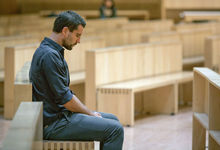When man and God turn to one another
God hears and God responds: how can prayer be experienced in this manner? A doctrinal article written by the Chief Apostle, which currently appears in the community member magazine and its sister publications, provides answers.

“Prayer — indispensable in all situations of life”—such is the title of an article appearing under the category of “Doctrine” in issue 4/2018 of community, a text which is also set to be printed in the German Unsere Familie and African Joy. The text corresponds to an article entitled “Reflections on prayer”, which was featured under the heading “Doctrine and Practice” in Special Edition 1/2018 of the Divine Service Guide, a publication for ministers of the Church.
In it, Chief Apostle Jean-Luc Schneider answers a whole series of questions surrounding the matter of prayer.
Why pray?
First and foremost, those who pray thereby profess their belief in the living God. After all, without this faith “it would be pointless to address Him or seek a response from Him”, it says in the article.
Those who pray also attest to their trust in God. This is because prayer “occurs on the basis of a direct need to turn to God, to give thanks to Him for gifts received, and to ask Him for help or support”.
Those who pray also desire to feel the nearness of God: “This experience leads believers to recognise God and feel His presence. They thereby learn that He is interested in human cares and concerns, and that He accompanies them on their way of life.”
How do we pray?
The supplicant is intent on aligning his entire life by God: by folding his hands he puts aside all other activities. By closing his eyes he reduces the chances of being distracted. And by kneeling down he expresses a special measure of humbleness.
“When we pray, God is our sole partner in dialogue,” emphasises the Chief Apostle. This applies as much to collective prayers in the divine service as to prayers uttered in private. “It is not the assembly of participants in the divine service who comprise the addressee, but rather God alone. In this way prayer is neither a monologue nor a speech to those assembled in prayer.”
Of what elements does prayer consist?
In adoration and worship, the supplicant reverently approaches the majesty of God, which is brought to expression in terms that draw attention to His holiness, omnipotence, and eternal being. This worship and adoration not only applies to our heavenly Father, but also to Jesus Christ.
Above all else, the believer owes thanks to God for his very existence as a part of God’s creation—whether or not he is considered successful by human standards. Only thereafter does the focus turn to experiences of God’s protection, accompaniment, and gracious care.
Petitions make it clear that God is the One to whom we can turn in all situations of life. He is not indifferent to those He has created, but rather desires their salvation.
Intercessions stem from the awareness that the supplicant is part of a community: he is created in the image of God like all other human beings, but beyond that, he is also a believer among other believers. Intercessions also result from the commandment to love one’s neighbour.
What do we pray for?
“Anything that moves and stirs within a human being’s heart—including our own needs and wishes, as well as the needs and wishes of others—is part of prayer,” writes Chief Apostle Schneider in conclusion. “Prayer incorporates fears and joys, health and sickness, life on the threshold of death, the magnificence of nature, and the beauty of humanity in fellowship and being there for one another, but also that which is unfathomable, such as the destruction that man inflicts on nature and other human beings. Prayer is therefore an indispensable element of a life defined by faith and following.”
Photo: fantom_rd - stock.adobe.com










